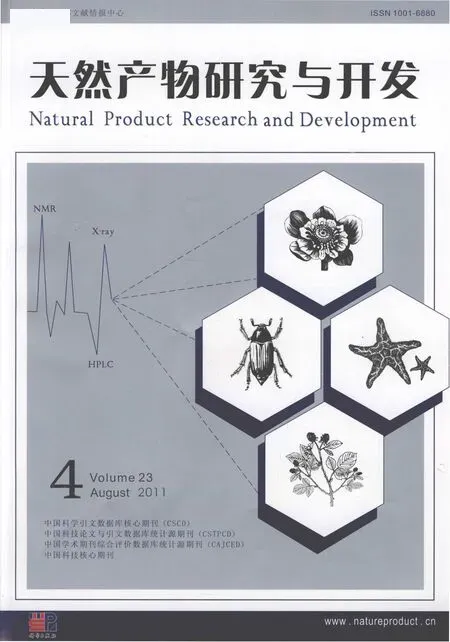线叶旋覆花的化学成分研究
聂利月,金慧子,严 岚,覃江江,张卫东,2*
1上海交通大学药学院,上海200240;2第二军医大学药学院,上海200433
Introduction
A number of plants in Inula genus are used as traditional herbal medicines to treat expectorant,anti-tussive,diaphoretic,and bactericidalthroughoutthe world.Recently,much attention has been paid to Inula genus due to their diverse biological activities,particularly in anti-tumor application[1].Actually,the investigation of the chemical constituents of Inula plants is the major course in our group,and many bioactive compounds have been reported[2,3].However,as far as Inula lineariifolia Turcz.is concerned,only a few compounds have been isolated from this plant[4].Herein,we report the isolation and elucidation of 13 compounds:eupatin(1),spinacetin(2),hispidulin(3), daucosterol(4),β-sitosterol(5),α-spinasterol(6),taraxasteryl acetate(7),(+)-syringaresinol(8),dehydrovomifoli(9),4-hydroxy-benzaldehyde(10),vanllin polymer(11),4-hydroxy-3,5-dimethoxybenzaldehyde(12),and 4-hydroxy-2,6-dimethoxybenzaldehyde (13).All compounds were isolated from I.lineariifolia for the first time.
Experimental
General procedures
Melting points were carried out on a RY-1 micro-melting point apparatus without correction.The ESIMS were recorded on Agilent-1100-LC/MSD-Trap(ESI-MS) and Agilent Micro-Q-Tof in m/z.NMR spectra were measured on a Bruker DRX-500 spectrometer with TMS as internal standard,operating at 500 MHz for1H and 125 MHz for13C chemical shift(δ)was given in ppm and coupling constants in Hz.Column chromatographies (CC)were performed on silica gel(200-300 mesh, Yantai,China)and sephadex LH-20(GE Healthcare Bio-Sciences AB,Sweden),and precoated silica GF254plates were used for TLC(Qingdao Haiyang Chemical Co.,Ltd.,China).
Plant material
The whole plants of I.lineariifolia Turcz.were collected in Changfeng County,Anhui Province,in late July 2007,and authenticated by Prof.Shou-Jin Liu(Anhui University of Traditional Chinese Medicine).A voucher specimen(No.XX20070701)is deposited in the School of Pharmacy,Shanghai Jiao Tong University.
Extraction and isolation
The air-dried and powdered aerial part of I.lineariifolia Turcz(60.0 kg)was extracted with 95%ethanol(3 ×10 L).Then the concentrated residue was suspended in H2O and partitioned with petroleum ether (PE),CHCl3,EtOAc,and n-BuOH successively.Part of PE extract(116.8 g from 1000.0 g)was subjected to silica CC eluting with a gradient of PE-EtOAc(100∶1-1∶2)to give 14 fractions(Fr.1-Fr.14)based on TLC analysis.Compounds 4(67.2 mg),5(25.2 mg),6(30.0 mg),and 7(25 mg)were separated from Fr.10,Fr.2,and Fr.1 respectively.Part of CHCl3extract(240 g from 600.0 g)was chromatographed over silica gel,eluting with increasing amounts of MeOH(0-100%)in CH2Cl2,to afford 11 fractions( F1-F11).Fractions F1,F4,and F5 were further subjected to sephadex LH-20 with MeOH as eluent to give the subfractions as follows:F1a-1d,F4a-4h,F5a-5f.The F1c,F4b,and F4i were further purified by preparative HPLC under MeOH-H2O system.F1c gave 10(2.8 mg),11(5.7 mg),12(8.3 mg),and 13(15.1 mg) by prep-HPLC with MeOH/H2O system(20%),F4i gave 9(2.6 mg)at MeOH/H2O(35%),and F4b gave 8(11.0 mg)at MeOH/H2O(45%).F5f was subjected to sephadex LH-20 eluted with MeOH repeatedly to yield 1(23.2 mg),2(40.5 mg),and 3(4.2 mg).
Structure identification
Compound 1 C18H16O8,yellow amorphous solid (MeOH),mp.206-209℃,ESI-MS(pos.)m/z 383.1[M+Na]+,ESI-MS(neg.)m/z 359.0[M– H]–;1H NMR(DMSO-d6+CDCl3,500 MHz)δ: 7.79(1H,d,J=1.5 Hz,H-6'),7.73(1H,dd,J= 8.5,1.5 Hz,H-2'),7.03(1H,d,J=1.5 Hz,H-5'),6.91(1H,s,H-8),4.04,4.00,3.91(3×3H,s,C-6,C-7,C-4'-OCH3);13C NMR(DMSO-d6+CDCl3,125 MHz)δ:150.5(C-2),138.8(C-3),179.3(C-4),150.2(C-5),131.2(C-6),156.9(C-7),91.4(C-8),155.2(C-9),106.6(C-10),123.2(C-1'),116.2(C-2'),147.2(C-3'),148.8(C-4'),112.6 (C-5'),122.3(C-6'),60.2(7-OCH3),56.7(7-OCH3),56.3(4'-OCH3).The NMR data was in accordance with those reported in the literature[5],and identified 1 as eupatin.
Compound 2 C17H14O8,yellow needles(MeOH),mp.122-124℃.ESI-MS(pos.)m/z 347.1[M+ H]+;ESI-MS(neg.)m/z 345.1[M-H]–;1H NMR (DMSO-d6,500 MHz)δ:12.37(1H,s,H-5),7.59 (1H,s,H-2'),7.47(1H,d,J=10.0 Hz,H-6'),6.91(1H,d,J=10.0 Hz,H-5'),6.83(1H,s,H-8),3.79,3.90(2×3H,s,C-6,C-3'-OCH3);13C NMR (DMSO-d6,125 MHz)δ:145.7(C-2),137.5(C-3),178.1(C-4),148.8(C-5),129.6(C-6),155.7 (C-7),90.8(C-8),154.5(C-9),105.5(C-10),121.0(C-1'),115.5(C-2'),145.2(C-3'),148.6 (C-4'),115.7(C-5'),120.5(C-6')56.3(3'-OCH3),59.6(6-OCH3).The NMR data was in accordance with those reported in the literature[5,6],and identified 2 as spinacetin.
Compound 3 C16H12O6,yellow amorphous solid (MeOH),mp.244-247℃,ESI-MS(neg.)m/z 299.1[M–H]–;1H NMR(DMSO-d6,500 MHz)δ: 3.75(3H,s,6-OCH3),6.59(1H,s,H-3),6.78 (1H,s,H-8),6.93(2H,d,J=10.0 Hz,H-3',5'),7.93(2H,d,J=10.0 Hz,H-2',6'),10.30(1H,s,4'-OH),10.70(1H,s,7-OH),13.10(1H,s,5-OH);13C NMR(DMSO-d6,125 MHz)δ:163.8(C-2),102.3(C-3),182.4(C-4),152.7(C-5),131.3 (C-6),157.3(C-7),94.2(C-8),152.4(C-9),104.0(C-10),121.2(C-1'),128.4(C-2'),115.9 (C-3'),161.1(C-4'),115.9(C-5'),128.4(C-6'),56.3(6-OCH3).The NMR data was in accordance with those reported in the literature[7,8],and identified 3 as hispidulin.
Compound 4 C35H60O6,white amorphous powder,mp.285-287℃,ESI-MS m/z 599.6[M+Na]+.TLC behavior was in accordance with that of authentic daucosterol when eluted with different developing solvents.Thus,compound 4 was determined as daucosterol.
Compound 5 C29H50O,white needles(MeOH); mp.139-140℃;ESI-MS m/z 437.4[M+Na]+;13C NMR(CDCl3,125 MHz)δ:37.3(C-1),31.7(C-2),71.8(C-3),42.3(C-4),140.8(C-5),121.7 (C-6),31.7(C-7),31.9(C-8),50.2(C-9),36.5 (C-10),21.1(C-11),39.8(C-12),42.3(C-13),56.8(C-14),24.3(C-15),28.2(C-16),56.1(C-17),11.9(C-18),19.1(C-19),36.1(C-20),18.8 (C-21),34.0(C-22),26.1(C-23),45.9(C-24),29.2(C-25),19.8(C-26),19.4(C-27),23.1(C-28),12.0(C-29).The above data were in accordance with those reported in the lierature[9].Therefore,compound 5 was identified as β-sitosterol.
Compound 6 C29H48O,white needle crystal (CH2Cl2),mp.160-162℃;ESI-MS m/z 413[M+ H]+.Compound 6 showed the same color and equal Rfvalue with standard substance of α-spinasterol when applied on TLC and eluted with different developing solvents.So compound 6 was characterized as α-spinasterol.
Compound 7 C32H52O2,white lamellar solid(PE),mp.237-239℃,ESI-MS(neg.)m/z 935.5[2M–H]–;1H NMR(CDCl3,500 MHz)δ:4.62(2H,m,H-30),4.48(1H,dd,J=12.5,3.0 Hz),2.04(3H,s,CH3CO),1,01(3H,d,J=8.5 Hz,H-29),1.00 (3H,s,H-26),0.90(3H,s,H-27),0.85(3H,s,H-23),0.82(3H,s,H-25),0.82(3H,s,H-25),0.82 (3H,s,H-28),0.81(3H,s,H-24);13C NMR (CDCl3,125 MHz)δ:38.5(C-1),26.7(C-2),81.0 (C-3),37.8(C-4),55.5(C-5),18.2(C-6),34.0 (C-7),40.9(C-8),50.4(C-9),37.1(C-10),21.5 (C-11),25.6(C-12),39.2(C-13),42.0(C-14),26.2(C-15),38.3(C-16),34.5(C-17),48.7(C-18),39.4(C-19),154.6(C-20),23.7(C-21),38.9(C-22),27.9(C-23),15.9(C-24),16.3(C-25),16.5(C-26),14.7(C-27),19.5(C-28),107.1(C-29),25.4(C-30),171.0(CH3CO),21.3 (CH3CO).The NMR data was in accordance with those reported in the literature[10],and identified 7 as taraxasteryl acetate.
Compound 8 C22H26O8,white powder(MeOH),mp.118-120℃,ESI-MS(pos.)m/z 441.2[M+ Na]+;1H NMR(CDCl3,500 MHz)δ:6.58(4H,s,H-2,H-8,H-2',H-8'),4.73(2H,d,J=3.75 Hz,H-7,H-7'),4.27(2H,m,He-9,He-9'),3.92(2H,m,Ha-9,Ha-9'),3.89(12H,s,4×OCH3),3.09(2H,m,H-8,H-8');13C NMR(CDCl3,125 MHz)δ:132.1 (C-1,C-1'),102.7(C-2,C-2'),147.1(C-3,C-3'),134.3(C-4,C-4'),86.1(C-7,C-7'),71.8(C-9,C-9'),56.4(4×OCH3),54.3(C-8,C-8').The spectral data was identical with those reported in the literature[11],and 8 was determined as(+)-syringaresinol.
Compound 9 C13H18O3,light yellow gum(MeOH),ESI-MS(pos.)m/z 245.1[M+Na]+;1H NMR (CDCl3,500 MHz)δ:1.01,1.09(each 3H,each s,H3-1,H3-2),1.89(3H,d,J=1.5 Hz,H-5),2.31 (3H,s,H-9),5.96(1H,s,H-4),6.47(1H,d,J= 15.5 Hz,H-8),6.82(1H,d,J=15.5 Hz,H-7);13C NMR(CDCl3,125 MHz)δ:41.4(C-1),49.6(C-2),196.9(C-3),144.9(C-4),160.2(C-5),79.3 (C-6),127.8(C-7),130.4(C-8),197.3(C-9),18.6(C-10),22.9(C-11),24.32(C-12),28.4(C-13).The spectral data was identical with those reported in the literature[12,13],and identified as dehydrovomifoli.
Compound 10 C7H6O2,colorless oil(CH2Cl2),ESIMS m/z 245.3[2M+H]+;121.1[M– H]–;1H NMR(CDCl3,500 MHz)δ:9.61(1H,m,H-1),7.68 (2H,d,J=9.0 Hz,H-2,H-6),6.77(2H,d,J=9.0 Hz,H-3,H-5).Compound 10 was characterized as 4-hydroxy-benzaldehyde by spectral analysis and comparison with standard substance of 4-hydroxy-benzaldehude when applied on TLC and eluted with different developing solvents.
Compound 11 C8H8O3,colorless oil,ESI-MS m/z 175.2[M+Na]+;151.0[M– H]–;1H NMR (CDCl3,500 MHz)δ:9.59(1H,m,H-1),7.38 (2H,m,H-2,H-6),6.79(1H,d,J=3.0 Hz),3.88 (3H,s,3-OCH3).Compound 11 was characterized as vanllin polymer by spectral analysis and comparison with standard substance when applied on TLC and eluted with different developing solvents.
Compound 12 C9H10O4,light yellow oil,ESI-MS m/ z 205.2[M+Na]+;1H NMR(CD3OD,500 MHz)δ: 9.70(1H,m,H-1),7.21(2H,s,H-2,H-6),3.91 (6H,s,3,5-OCH3).Compound 12 was characterized as 4-hydroxy-3,5-dimethoxy-benzaldehyde by spectral analysis and comparison with standard substance when applied on TLC and eluted with different developing solvents.
Compound 13 C9H10O4,light yellow oil,ESI-MS m/ z 205.2[M+Na]+;181.1[M-H]–;1H NMR (CDCl3,500 MHz)δ:5.86(2H,s,H-2,H-6),3.83 (6H,s,2,4-OCH3).Compound 13 was characterized as 4-hydroxy-2,6-dimethoxy-benzaldehyde by spectral analysis and comparison with standard substance when applied on TLC and eluted with different developing solvents.
Reference
1 Zhao YM,Zhang ML,Shi QW,et al.Chemical constituents of plants from the genus Inula.Chem Biodivers,2006,3:371-384.
2 Qin JJ,Jin HZ,Fu JJ,et al.Japonicones A-D,bioactive dimeric sesquiterpenes from Inula japonica Thunb.Bioorg Med Chem Lett,2009,19:710-713.
3 Qin JJ,Jin HZ,Fu JJ,et al.Advances in studies on the pharmacological activities of Inula genus plants.Nat Prod Res Dev,2008,20:442-445.
4 Qian MK,Chen ZN,Qin GW,et al.Studies on the chemical constituents of Inula linariaefolia Turcz.Acta Chin Sin,1983,41:254-260.
5 Bai NS,Zhou Z,Zhu NQ,et al.Antioxidative flavonoids from the flower of Inula Britannica.J Food Lipids,2005,12:141-149.
6 Geng HM,Zhang JY,Zhang DQ.Studies on chemical constituents of Inula Britannica L..Chin Tradit patent Med,2008,30:1188-1189.
7 Li YN,Zhang GG,Mao DS,et al.Chemical constituents of Belamcanda chinensis(L.)DC.Central South Pharm,2007,5:222-224.
8 Zhou LD,Yu JG,Guo J,et al.Compounds from roots of Chirita fimbrisepala Hand.-Mazz.China J Chin Mater Med,2001,26:114-117.
9 Luo XR,Li B,Nian JX,et al.Studies on chemical constituents of Alternanthera philoxeroides.Chin Pharm J,2007,42: 1138-1140.
10 Xue HQ,Yang HP,Wang HQ.Study on triterpenes of Ligularia xanthotricha.China J Chin Mater Med,2008,33:272-275.
11 Ma JY,Wang ZT,Xu LS,et al.Chemical constituents of Lxeris sonchifolia Hance.J China pharm Univ,1998,29:94-96.
12 Gao YD,Yang XW,Ai TM.Chemical constituents of whole herb of Dicliptera chinensis.Chin Tradit Herb Drugs,2007,38:14-17.
13 Tadahiro K,Mrtsuaki T,Nobuki S,et al.Growth and germination inhibitors in rice husks.Phytochemistry,1977,16:45-48.
———记第二军医大学免疫学研究所副教授侯晋
- 天然产物研究与开发的其它文章
- 藏药船型乌头中的生物碱成分
- 成都普瑞法科技开发有限公司

